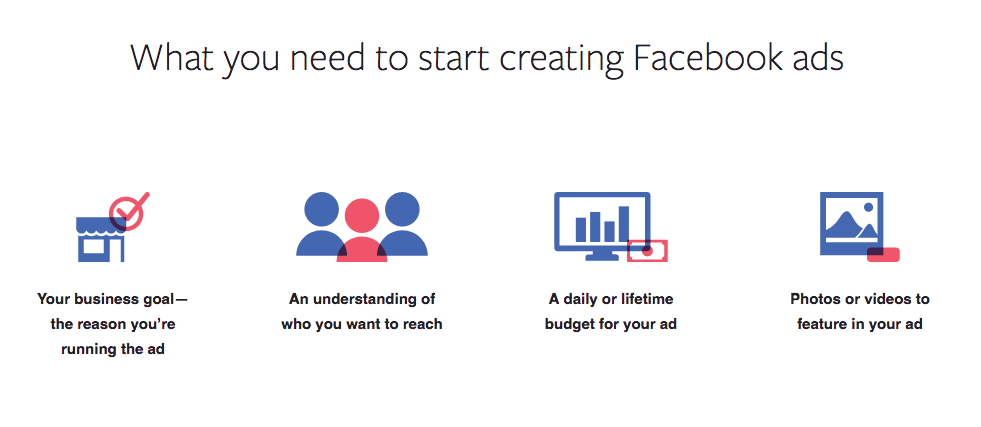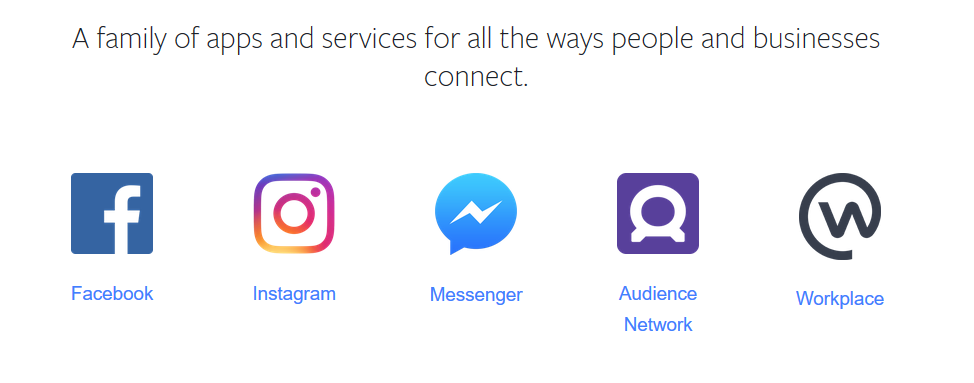What You Need To Start Advertising On Facebook

Facebook is by far the largest social media network, having over 2 billion active monthly users in 2018. That means over ¼ of the world uses Facebook, creating immense opportunities for networking, marketing and advertising. Facebook offers a huge number of ways to reach your target audience.
The Four Areas
Business Goal- When you first start planning an ad, the first thing you will be asked is what is your marketing objective? There are many options here, separated into 3 categories, Awareness, Engagement and Conversion. Awareness is pretty similar to what it sounds, building brand awareness among consumers. Engagement means getting people to interact with your brand by following, and learning about your company and what you offer and grooming potential customers. Lastly, conversions is simply getting people to take a definitive action, that could be a purchase, sign-up, whatever your goal here is. So what should you select? This is dependent on your marketing objective, what are you trying to do with your ad campaign?
Your Audience- After the objective, you then can select your target audience. There are also several choices here, from picking demographics, location and interests to create a core audience, or uploading your own information to make a custom audience. If you create a core audience, you will select traits that you believe would make people like your brand or product, using information about people such as their hobbies. This is the easiest way, and still delivers enough customization for running your ad. If you already have a large customer base, and you have data on them, you can upload that to create a custom audience in order to engage with your existing customers. In term of choosing which one, the customization tools with a core audience can be extremely specific, and work with any campaign. However if you already have extensive customer data, the custom audience could be more useful depending on your objective.
Content- As far as content goes, Facebook Ads are primarily visual. Publishing a Facebook Ad means you will be using an image or video to capture your audience’s attention. The two main primary ads are Photo Ads and Video Ads, which are self explanatory, a photo or video usually with accompanying text or a link. Carousel Ads are a step up from Photo Ads in that you have an interactive photo carousel showing multiple photos that can be swiped through. These are great for showing off multiple versions of a product, or even doing one stretch image across multiple images if you want to be creative. They can also include a short description above or a link inside. Collection Ads are different from the other two, because they typically have one large photo or video featured and then other smaller ones in a row below. The main feature here is when someone clicks on your main photo or video, they are shown a full-screen interactive experience that you build. That can include scrolling through things or full screen video, etc. This can result in better brand engagement, and is a great way to showcase a product with the multiple images and interactivity.
The most important thing from here is that no ad format fits all. Based on your product or service, you will have to pick the format that looks like it will work the best, and don’t be afraid to experiment or test with multiple formats.
Budget- After all that, it is time to select your budget and schedule. Here, you can choose a daily or lifetime budget and also many delivery options. These delivery options include being able to have manual control over your bid price, picking if you want your ads shown earlier or throughout the day, and setting up a schedule. Running your ad on a schedule can be a good way to maximize a tight budget, since you can serve your ads only at times you think your target audience will be on Facebook.
Advanced Tactics
Placement- Beyond the basics of setting up your ad, there are many choices of where to run your ad. Facebook offers many choices here, as ads can be run on Facebook, Instagram, Messenger, or on the Audience Network. While the first three may be more straightforward, the Audience Network is a bit different. Here, your ad will be placed on 3rd-party apps and websites, very similar to how Google places display ads on external sites. This can be useful to reach people who might not be on Facebook, but you have less control over how your ad will display, as that will be determined based upon your objective selected earlier. You can also choose to have your ads display only on certain mobile devices. While this may not seem too useful initially, take the example of you being a cell phone case manufacturer. When the next iPhone comes out, you could target people using only that device, who are much more likely to be needing a case than a random person.
Knowing these things, you are well on your way to becoming an expert at running Facebook Ad Campaigns. However I could not discuss every nuance of running ads there in this single blog post, so I would recommend visiting Facebook’s Advertising site here and reading through it as well.
https://www.facebook.com/business/products/ads


